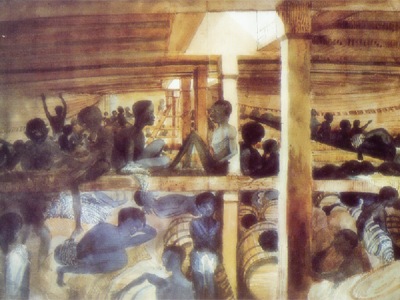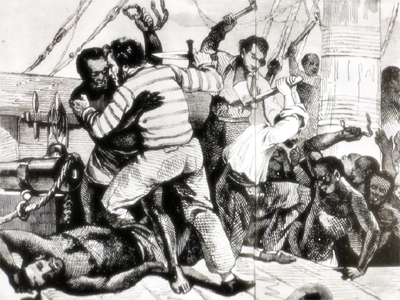|
The Middle Passage
"The stench of the hold…was so intolerably loathsome that it was dangerous to remain there for any time…but now that the whole ship’s cargo were confined together, it became absolutely pestilential. The closeness of the place and the heat of the climate, added to the number in the ship which was so crowded that each had scarcely room to turn himself, almost suffocated us"
Olaudah Equiano
|
Background
The Middle Passage did not begin with the transatlantic voyage, but with the capture and sale of Africans, and ended with their forced ‘adjustment’ to life in the Americas. It is one of history’s most horrific chapters, showing the human capacity for both cruelty and insensitivity and strength and survival. It is difficult to calculate the numbers of Africans that were transported; estimates have ranged from five million to 30 million. Further millions died during capture and on the journey across the Atlantic. History has seen few social disruptions on such a scale.
|
 Africans being forced below deck before transportation to
the Caribbean and Americas.
© Anti-Slavery International
|
|
The voyage itself took between 6 and 8 weeks. The enslaved Africans were chained together by the hand and the foot, and packed into the smallest places where there was barely enough room to lie on one’s side. It was here that they ate, slept, urinated, defecated, gave birth, went insane and died. They had no idea where they were going, or what was going to happen to them. Through all this misery and suffering, new African identities were created, forming a basis for a new transnational culture. Within these ships, Africans from different countries, regions, cultures and with different languages learned to communicate with each other; many conspired to overthrow their captors together.
|
|
British eyewitness accounts were used to support the anti-slavery campaign. Alexander Falconbridge, a former slave ship’s surgeon wrote his in 1788 which described the loss of life, the state of the holds below deck, and how some severely depressed Africans willed themselves to die:
"A woman was dejected from the moment she came on board, and refused both food and medicine; being asked by the interpreter what she wanted, she replied ‘nothing but to die’, and she did die".
|
 View of the Deck of the Slave Ship Alabanoz by Lieutenant Francis Meynell, 1846
© The Atlantic Slave Trade and Slave Life in the Americas: A Visual Record
|
|
Others chose to express their resistance more violently – "a man sold with his family for witchcraft", testified Dr Trotter at the parliamentary select committee, "refused all sustenance after he came on board. Early the next morning it was found that he had attempted to cut his own throat. [Dr Trotter] sewed up the wound, but the following night the man had not only torn out the sutures, but had made a similar attempt on the other side. He declared that he would never go with white men…he died of hunger in eight or ten days".
|
 Revolt aboard a slave ship
© The Atlantic Slave Trade and Slave Life in the Americas: A Visual Record
|
Narratives from the Collection
The African Slave-Trade and its Remedy
An Account of Slave Trade on the Coast of Africa
An essay on the comparative efficiency of Regulation or Abolition, as applied to the slave trade
Observations on the slave trade from the coast of Guinea, during a voyage made in 1787 and 1788
An abstract of the evidence delivered before a select committee of the House of Commons in the years 1790 and 1791, on the part of the petitioners for the abolition of the slave trade
|
Test Your Knowledge
|

